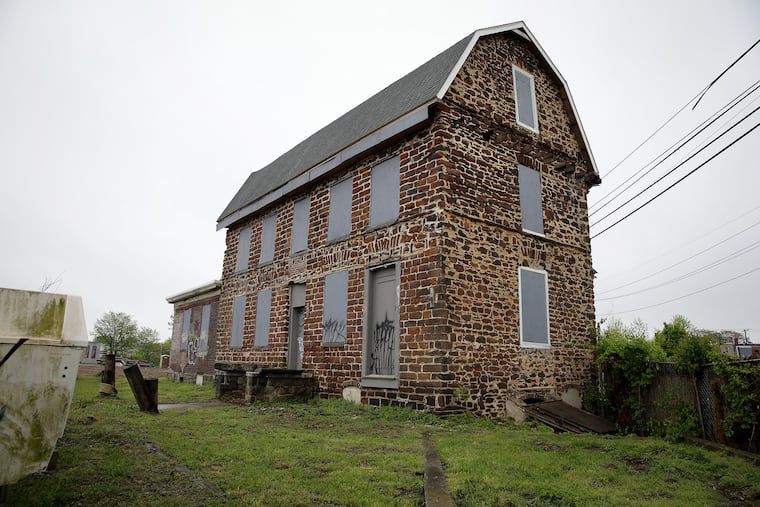Preserving a house that is Camden’s direct link to 1776
A historic house in the part of North Camden once known as Cooper's Point is being eyed as a potential home for a South Jersey Museum of the American Revolution.

A long-vacant North Camden house that embodies more than three centuries of history may be reborn as the South Jersey Museum of the American Revolution in time for the nation’s 250th birthday in 2026.
The Camden County Historical Society is energetically exploring this idea as a way to preserve, restore, and re-purpose the building on the privately owned, 17-acre property at 75 Erie St. A subterranean portion of the house may date to the late 17th century, when Europeans first settled in what became known as Coopers Point.
But whatever comes of the society’s ambitious and admirable effort, the house — built in 1734, named for Benjamin Cooper, the grandson of Camden’s founders, and commandeered by British troops during the Revolutionary War — must be preserved.
Losing this tangible, largely intact connection to the history of the city, the region, and the country would be a crime.
“There is no other place and no other building in Camden that has a more interesting historical story," said society treasurer Robert Shinn.
“This site was the center of ferry operations to Philadelphia, and all roads led there," he said. “It was the headquarters of the British army and was the nexus of a lot of war activities, including a skirmish involving major figures like Gen. Casimir Pulaski.”
The New Jersey affiliate of the national nonprofit Crossroads of the American Revolution “is excited about sites like [the Cooper house] that are looking to preserve their history and tell their story,” executive director Janice Selinger told me. As part of its preparations for 2026, Crossroads also will assess where to locate a visitor center, or centers, in the state, she said.
As a museum, visitor center, or both, the Benjamin Cooper House could be a showcase for the substantial, if relatively little known, role that individuals and communities in what is now Camden County played in the Revolutionary War, such as the 1777 Battle of Gloucester. Such a facility also could promote sites of significant Revolutionary battles or events elsewhere in South Jersey, including Red Bank in Gloucester County and Salem County’s Hancock’s Bridge.
No wonder Shinn and other society officials are determined to make sure the Benjamin Cooper House does not wind up like Bellmawr’s Hugg-Harrison House, a Colonial-era structure that also figured in the Revolutionary War but was pulverized to dust just before dawn on March 3, 2017, as part of the “Direct Connection” realignment of I-295 and Route 42. A lawsuit the society filed against state and federal transportation agencies, seeking mitigation for the loss of Hugg-Harrison, is before U.S. District Court Judge Renee Bumb.
The Benjamin Cooper House is listed on the state register of historic places and was deemed eligible for inclusion on the national register nearly 40 years ago. The society is asking the city to include it on the municipal registry as well. The society also has been granted permission by Flow Development & Technology, the Philadelphia company that owns the Cooper house, to seek state funding for a feasibility study of re-using the building as a museum.
“We reached out and have had discussions with the owners, and they’ve been very amenable and cooperative,” said society president Chris Perks.
Chadwick Smith, who is not an owner of the property but is a member of the current development team, said the house “is very important to the overall development" plan for the site. “It’s a focal point and a way to bring the community in,” he said, adding that the museum idea seems like a good one.
I left voice and email messages for other principals of Flow or its predecessor company and was unable to reach them. But the owners or their representatives have met with some neighborhood organizations, including the Camden Lutheran Housing Corp.
“They told us they recognized the house is historic, and said there were no plans to tear it down. They made that very clear,” Camden Lutheran executive director Betsy Clifford said. “It is the neighborhood’s intention that it be preserved.”
On Thursday, Clifford, a company representative, society officials, and architects took a tour of the interior of the house.
“My takeaway was that the building is in incredibly good shape, considering what it’s been through,” said Margaret Westfield, a preservation architect in Haddon Heights. A suspicious fire on Thanksgiving Day 2012 destroyed the roof (it has since been replaced) but did remarkably little damage to the lower portions of the building.
“There is what looks like an original, Georgian-style balustrade on the stairway leading to the attic," said Westfield. "It’s amazing that it survived.”
The Benjamin Cooper House later was used as a tavern called the Old Stone Jug, and as offices for a shipbuilding company that employed 3,000 workers. A succession of owners used the property until 2010.
Longtime historian Ed Fox said he saw what looked to him like evidence of an earlier basement beneath one part of the basement of the 1734 house.
“What we’re hoping to do is not just preserve the building, but to make it a resource everybody in the community can learn from,” Perks, the society president, said.
“People need to have access to the history, and the heritage. They need to know the story.”